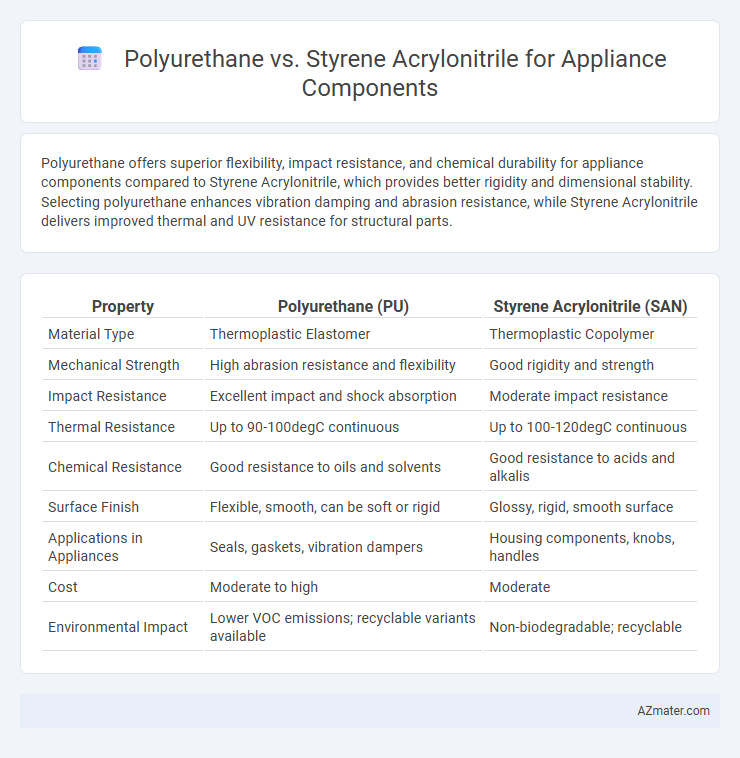Polyurethane offers superior flexibility, impact resistance, and chemical durability for appliance components compared to Styrene Acrylonitrile, which provides better rigidity and dimensional stability. Selecting polyurethane enhances vibration damping and abrasion resistance, while Styrene Acrylonitrile delivers improved thermal and UV resistance for structural parts.
Table of Comparison
| Property | Polyurethane (PU) | Styrene Acrylonitrile (SAN) |
|---|---|---|
| Material Type | Thermoplastic Elastomer | Thermoplastic Copolymer |
| Mechanical Strength | High abrasion resistance and flexibility | Good rigidity and strength |
| Impact Resistance | Excellent impact and shock absorption | Moderate impact resistance |
| Thermal Resistance | Up to 90-100degC continuous | Up to 100-120degC continuous |
| Chemical Resistance | Good resistance to oils and solvents | Good resistance to acids and alkalis |
| Surface Finish | Flexible, smooth, can be soft or rigid | Glossy, rigid, smooth surface |
| Applications in Appliances | Seals, gaskets, vibration dampers | Housing components, knobs, handles |
| Cost | Moderate to high | Moderate |
| Environmental Impact | Lower VOC emissions; recyclable variants available | Non-biodegradable; recyclable |
Introduction to Appliance Component Materials
Polyurethane offers superior flexibility, durability, and resistance to abrasion, making it ideal for appliance components requiring impact absorption and sealing. Styrene acrylonitrile (SAN) provides excellent rigidity, dimensional stability, and chemical resistance, suitable for structural parts and housings in appliances. Both materials are selected based on performance criteria such as mechanical strength, thermal stability, and environmental exposure in appliance manufacturing.
Overview of Polyurethane Properties
Polyurethane exhibits excellent flexibility, abrasion resistance, and impact strength, making it ideal for appliance components requiring durability and resilience. Its superior thermal stability and chemical resistance enhance component longevity in varied operating environments. Polyurethane's ability to be molded into complex shapes with consistent performance distinguishes it from Styrene Acrylonitrile in high-stress applications.
Key Characteristics of Styrene Acrylonitrile (SAN)
Styrene Acrylonitrile (SAN) offers superior chemical resistance and excellent dimensional stability, making it a preferred material for appliance components exposed to harsh detergents and frequent cleaning cycles. SAN provides high rigidity and clarity compared to Polyurethane, which is more flexible but less resistant to solvents and heat. The thermal resistance of SAN up to around 100degC ensures durability in household appliances, while its excellent electrical insulation properties enhance safety in electronic components.
Mechanical Strength Comparison
Polyurethane offers superior mechanical strength compared to Styrene acrylonitrile (SAN), exhibiting higher tensile strength and elasticity which enhances durability in appliance components subjected to stress and impact. SAN provides moderate strength with excellent rigidity and resistance to deformation but may fail under prolonged mechanical loads where polyurethane maintains structural integrity. The choice between polyurethane and SAN depends on the required balance between flexibility and hardness, with polyurethane preferred for components needing shock absorption and SAN selected for rigid, dimensionally stable parts.
Thermal Resistance and Stability
Polyurethane offers excellent thermal resistance withstanding temperatures up to 120degC, making it suitable for appliance components exposed to moderate heat. Styrene acrylonitrile (SAN) exhibits superior thermal stability, maintaining structural integrity at temperatures around 100-120degC, but it tends to degrade faster under prolonged thermal stress compared to polyurethane. When selecting materials for appliance parts, polyurethane's flexibility and better heat endurance often provide enhanced durability in fluctuating thermal environments.
Chemical Resistance and Durability
Polyurethane exhibits superior chemical resistance against oils, solvents, and detergents commonly found in appliance environments, making it highly durable for long-term use. Styrene acrylonitrile (SAN) offers good hardness and rigidity but is more susceptible to chemical degradation from strong acids and bases compared to polyurethane. For appliance components requiring enhanced durability and resistance to harsh chemicals, polyurethane provides a more reliable material choice.
Cost Analysis and Economic Viability
Polyurethane typically offers higher durability and flexibility for appliance components but comes at a greater material and processing cost compared to Styrene Acrylonitrile (SAN). SAN, while less impact-resistant, provides a lower-cost option with easier manufacturability and better dimensional stability, making it economically viable for mass-produced, budget-friendly appliances. Cost analysis reveals SAN's balance of affordability and adequate performance often results in better overall economic viability for large-scale appliance manufacturing.
Processing and Manufacturing Considerations
Polyurethane offers excellent flexibility and impact resistance, making it suitable for complex appliance components that require durability and cushioning, but it typically involves longer curing times and more intricate processing steps including mixing and molding. Styrene acrylonitrile (SAN) provides superior dimensional stability and ease of injection molding, enabling high-volume production with consistent quality and faster cycle times. Manufacturing with SAN reduces post-processing requirements due to its good flow properties and resistance to warpage, while polyurethane processing demands precise temperature control to ensure optimal polymerization and mechanical properties.
Environmental Impact and Sustainability
Polyurethane components in appliances offer enhanced durability with potential for recycling through mechanical or chemical processes, reducing environmental footprint compared to Styrene acrylonitrile (SAN), which is less biodegradable and generates more persistent plastic waste. SAN production involves styrene and acrylonitrile monomers derived from non-renewable petrochemicals, contributing to higher carbon emissions and resource depletion, whereas polyurethane formulations can incorporate bio-based polyols, improving sustainability metrics. Lifecycle assessments reveal that polyurethane's adaptability to eco-friendly additives and recycling options positions it as a more sustainable choice for appliance components than SAN, which faces challenges in end-of-life management and environmental persistence.
Application Suitability: Polyurethane vs SAN in Appliances
Polyurethane offers exceptional flexibility, abrasion resistance, and impact strength, making it ideal for appliance components subjected to frequent mechanical stress, such as seals, gaskets, and handles. Styrene acrylonitrile (SAN) provides excellent dimensional stability, clarity, and chemical resistance, suitable for rigid, visible parts like control panels and housings in appliances. Choosing between polyurethane and SAN depends on the specific appliance application requirements, prioritizing durability and flexibility for moving parts versus rigidity and aesthetic appeal for exterior components.

Infographic: Polyurethane vs Styrene acrylonitrile for Appliance component
 azmater.com
azmater.com